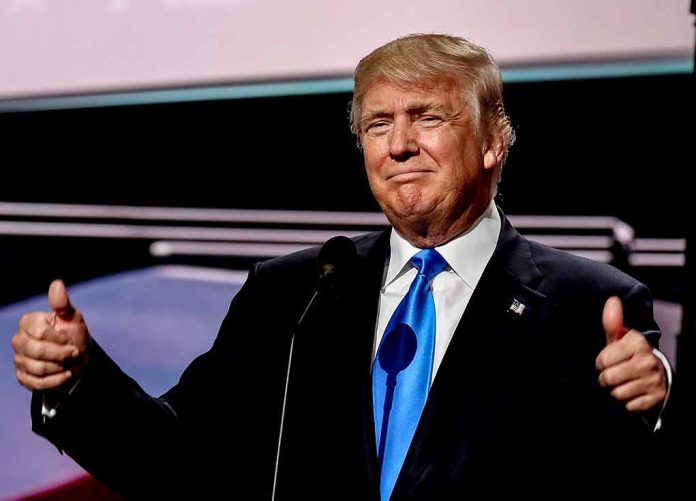
President Trump issued a new executive order targeting sanctuary cities, threatening to withhold federal funding if they continue to defy immigration enforcement authorities.
Key Takeaways
- President Trump signed an executive order that could strip federal funding from sanctuary cities that don’t comply with federal immigration laws
- The order directs the Justice Department to identify sanctuary jurisdictions and mandates that undocumented residents in these areas be denied federal benefits
- Attorney General Pam Bondi and DHS Secretary Kristi Noem are tasked with pursuing legal actions against non-compliant cities
- Several major cities including Chicago, New York, Boston, and Los Angeles, as well as states like California and Illinois, currently maintain sanctuary status
- Some jurisdictions are already adjusting policies, including NYC Mayor Eric Adams allowing ICE to operate at Rikers Island for criminal matters
Trump’s New Order Takes Aim at Sanctuary Policies
President Donald Trump has signed a significant executive order targeting sanctuary cities across America that refuse to cooperate with federal immigration authorities. The order threatens to withhold federal funding from jurisdictions that maintain policies limiting cooperation with Immigration and Customs Enforcement (ICE) officials. This action fulfills one of Trump’s key campaign promises to accelerate deportations and enforce federal immigration laws more aggressively throughout the country.
The executive order specifically directs the Justice Department to compile a comprehensive list of sanctuary jurisdictions and potentially cut funding to areas that don’t comply with federal immigration authorities. Cities and states will have an opportunity to adjust their policies before funding is removed. The order also seeks to prevent residents of sanctuary cities from receiving federal public benefits, creating additional pressure on local governments to cooperate.
President Donald Trump signed an executive order Monday that directs federal and state officials to compile lists of so-called "sanctuary" jurisdictions and prepare to cut their federal funds. https://t.co/cFXhl3pJ38
— LEX 18 News (@LEX18News) April 29, 2025
Federal Enforcement Mechanism and Legal Challenges
Attorney General Pam Bondi and Department of Homeland Security Secretary Kristi Noem have been tasked with pursuing legal actions against cities and states that refuse to comply with the executive order. The administration faces potential legal challenges, as a previous federal judge ruled against similar Trump administration efforts to restrict federal funds to sanctuary cities, citing constitutional violations. This current order has been carefully crafted to potentially withstand such legal scrutiny.
“It’s quite simple: obey the law, respect the law, and don’t obstruct federal immigration officials and law enforcement officials when they are simply trying to remove public safety threats from our nation’s communities. The American public don’t want illegal alien criminals in their communities. They made that quite clear on November 5, and this administration is determined to enforce our nation’s immigration laws,” said White House Press Secretary Karoline Leavitt.
The White House has cited numerous examples of sanctuary jurisdictions refusing to cooperate with ICE, which they claim has resulted in crimes committed by illegal immigrants who could have been deported. This executive order is part of Trump’s broader agenda, with the president having signed over 140 executive orders within his first 100 days back in office, many focusing on immigration enforcement and border security.
Current Sanctuary Jurisdictions and Early Reactions
Many major cities maintain sanctuary policies, including Chicago, New York City, Boston, and Los Angeles. Several states have also enacted sanctuary protections, including California, Oregon, Washington, and Illinois. These policies typically limit local law enforcement from cooperating with federal immigration authorities or sharing information about a person’s immigration status. The administration has described these policies as creating “death traps” and enabling a “lawless insurrection” against federal authority.
“These reckless policies in Democrat-run cities and states across our nation have led to too many preventable tragedies. They also endanger ICE agents who are forced to take more difficult enforcement actions in jurisdictions that refuse to cooperate with federal immigration authorities,” stated House Committee on Oversight and Government Reform Chairman James Comer, R-Ky.
Some jurisdictions have already begun adjusting their policies in anticipation of federal pressure. New York City Mayor Eric Adams recently modified some of the city’s immigration policies, allowing ICE agents to operate at Rikers Island jail for criminal matters. This signals that the executive order may already be influencing local policy decisions, even as many cities publicly maintain their commitment to protecting immigrant communities from what they consider overly aggressive federal enforcement.
Sources:
- Trump signs executive order highlighting sanctuary cities fighting immigration enforcement
- Trump signs executive order cracking down on ‘sanctuary’ cities, threatens their federal funding
- Trump Puts Sanctuary Cities On Notice With New Executive Order






